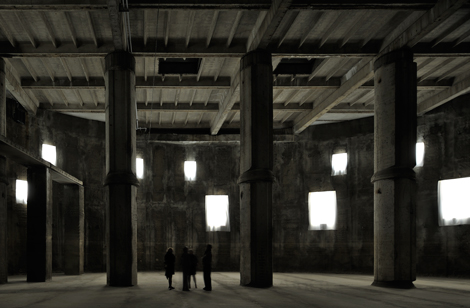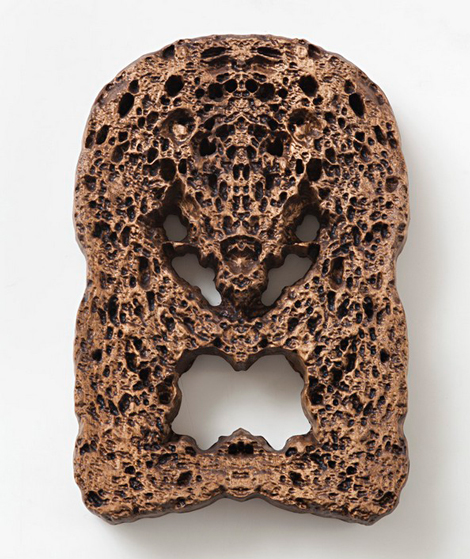Nights CAN BE long in Moscow. But come spring, as the light fades ever more slowly, the evenings get off to a late start. Which may be why I inadvertently kept a driver waiting on the evening of April 3rd to ferry me and another journalist to the sprawling Artplay Design Center in the Kurskaya district of Moscow for the Seventh Annual Innovation Prize award ceremonies. In lieu of the press preview of Prize nominees which had begun while I was still en route, the two of us had taken a leisurely stroll around the Arbat neighborhood, where we were staying, and visited the from-the-ground-up replica Cathedral of Christ the Redeemer—as much a symbol of Russian redemption from Stalinism as religious resurgence.
Artplay, one of several industrial facilities in Moscow to be reconfigured into an “art cluster,” is an exhibition facility fit for a megalopolis. On a multiple–football field–length expanse of its mezzanine level is what seems like half the Moscow art world, along with a phalanx of media from Russian outlets to Bloomberg, the Wall Street Journal and the Financial Times.
One of the first people I’m introduced to is a gaunt, cerebral-looking gentleman, who turns out to be Alexander Brodsky. His “Cisterna” has been nominated for (and ends up winning) the Innovation Prize for Best Work of Visual Art. But the moment is almost completely lost on me, his identity blurred in the cacophony of the moment, as I try to distinguish him from the Alexander Borovsky (of the State Russian Museum in St. Petersburg), who’s one of the jurors, and Alexander Gronsky, a photographer who’s been nominated for the Innovation “New Generation” Prize. It’s not for two or three days, not long after I’ve seen the documentation for the dramatic “Cisterna” installation, that I finally realize Brodsky may be one of the few contemporary Russian artists I’ve encountered off Russian soil. His work has not only been exhibited in New York (and elsewhere) since the 1990s; he actually lived in New York between 1996 and 1999 and was included in the Guggenheim’s huge “Russia!” survey of 2005.
For the moment, though, there are curators, collectors, museum officials, gallery directors, other media folks and a smattering of the award nominees who I’m trying (in vain) to correlate to the categories they’re nominated in. Standing like a beacon in this scrum is the Innovation Prize director, Christina Steinbrecher, resplendent in a long acid-chartreuse dress, whose success as the director of Moscow’s Central House of Artists and art director of the ArtMoscow fair, and more specifically, in negotiating the divergent political currents in the Russian art world generally, doubtless played into her appointment to the position. Politics have played no small role in both major Russian art prizes—the Kandinsky, sponsored by the ArtChronika Cultural Foundation, the philanthropic arm of ArtChronika, Russia’s dominant art publication; and the Innovation Prizes, sponsored by the National Center for Contemporary Art, which maintains branches in St. Petersburg and the Urals as well as Moscow.
If there was any thought that the state-supported NCCA might be reticent to unleash the politically unorthodox, the 2005 debut of the Innovation Prizes put that fear to rest. Both the Kandinsky and Innovation Prizes have gone to politically controversial nominees. The 2008 Kandinsky Prize winner, Aleksey Belyaev-Gintovt, was critically assailed for the neo-Stalinist aesthetic of his plainly nationalistic “Daughter Russia.” Last year’s Innovation Prize for the Best Work of Visual Art went to the firebrand art collective Voina (War) for one of its most spectacular protest gestures—a 65-meter length graffiti phallus painted on the underside of a drawbridge that crossed directly to the St. Petersburg headquarters of the FSB (formerly, KGB). One of the collective members, Alexei Plutser-Sarno publicly scorned the nomination as a co-optation—all of a piece with the controversy that swirls around these contests. A cursory scan of response by nominees and winners of these prizes makes it clear that biting the hands that feed us is the default posture for the artist who suffers to be recognized.
Still, it was hard to escape the sense that Innovation’s nominating committee had taken a step back from political outrage. In a conversation not long before the jury convened to decide upon the final awards, Steinbrecher herself took note of the public ambivalence and conflicting attitudes that colored the political backdrop.
In the meantime, another art (or, as self-described, “feminist punk/rock”) street performance collective, Pussy Riot, was responding to this ambivalence in its chosen fashion—with a guerilla performance staged in that aforementioned symbol of resurgent and conflicting Russian aspirations, the Church of Christ the Redeemer, provoking the two-fold wrath of Moscow’s law enforcement and the Orthodox Patriarch of Moscow. Three members of the band were detained and still jailed on the evening of the Innovation awards. (They remain in jail—an international cause célèbre.)
The elaborately staged Innovation Awards were televised with the Aidan Gallery’s own Aidan Salakhova and Moscow publisher Philipp Dzaydko hosting the telecast. Only days later I learned that Salakhova would be closing her gallery in the Winzavod gallery complex to focus on her own studio practice, which seemed to fit a certain economic/behavioral pattern in the evolving Moscow art world. Open big (preferably in a landmark industrial space), close quietly/suddenly, and reappear as something else, maybe even somewhere else.
Winzavod is not very far from Artplay, but seems worlds apart from its retro-futurist aspect. Winzavod is a vast 19th-century winery transformed into a complex of gallery/exhibition, performance and studio spaces, architectural and design offices, including an attractive café and retail space. But the approach from the Kursky train station retains a certain grittiness—traversing a motley assemblage of fast food joints and novelty hawkers, and finally an underpass that features amazing graffiti. Depending upon what’s being exhibited at the galleries, the street art, some of it in all probability by Moscow’s most famous street artist, Misha Most, may be the highlight of the excursion. Although Elena Panteleeva, Winzavod’s director, wasn’t specific about gallery comings and goings, it was clear by the time I left Moscow that the commercial gallery rentals at Winzavod were just half of what they had been only two years earlier.
Winzavod’s nominee for Innovation’s hotly contested “New Generation” award (co-sponsored by the Stella Art Foundation) had been Valery Chtak, an artist represented by the complex’s Paperworks Gallery.
But when the smoke cleared we learned that the award would go to Louise Brooks–bobbed Taus Makhacheva, for her video installation, “The Fast and the Furious.” (Alexander Gronsky took home a special British Council award for his photographic series, “Pastoral.”)
Makhacheva’s work might be called conceptual—but “The Fast and the Furious” is also very personal. It took Makhacheva back to her family’s ancestral roots in Dagestan, a semi-autonomous region of the Caucasus with a distinctly macho (and car) culture, and involved a bit of performance on the artist’s part. A week later, Makhacheva opened another, even more controversial, multi-channel video installation drawing on the aggressive alpha-male culture of Dagestan—this one documenting dog fights and their participants in tandem with documentary footage of a freestyle wrestling champion—at the Paperworks Gallery.
Upon entering the discreet quarters of the Stella Art Foundation one could be forgiven for hearing echoes of that open-close rhythm of Moscow’s commercial art world. Its gallery was featuring an exhibition of painted fans by Andrei Fillipov, that opened and closed explosively as painted light fixtures went on and off directly behind them. Unlike many “oligarchettes” who have pursued their art collecting ambitions abroad—among the blue-chip international brands at auctions in London and New York—Stella Kesaeva has kept her focus on Russia.
Which is not to say that Kesaeva has entirely ignored the international art world. When I sit down to chat with Nikolai Molok, the Stella Foundation’s development director, I do so in full view of a large portrait of Kesaeva by Alex Katz, with a Damien Hirst dot painting on the opposite wall and a Koons balloon dog off to one side. Molok emphasized that the core mission of the Stella Foundation was to support the Moscow Conceptualists. Beyond that, the foundation sought out artists from every region, including the former Soviet republics, to showcase on and off the foundation premises.
The ever-expanding scope of the Stella Foundation’s activities would lead one to believe that it would soon outgrow its quiet location; and indeed Kesaeva and her foundation have ambitions for a full-blown contemporary art museum—a joint public-private venture to be housed in a former bus garage designed by Konstantin Melnikov—not to be confused with the Garage complex (designed by the same architect) Moscow-London-LA art-fashion oligarchette Dasha Zhukova recently closed, and reportedly intends to reopen.
If it seemed to some that the Innovation ceremony wrapped anticlimactically, it probably had less to do with the nominees’ distance from political gesture or controversy than a sense that a good deal of the recognition memorialized by the awards—especially Brodsky’s— was overdue. A special award was given to Zurab Tsereteli, a sculptor and philanthropist, “for the support of Russian contemporary art.” Not until later that week would I learn what an understatement that was.
I did not see Brodsky or Tsereteli at the sumptuous after-party, but it seemed as if every other important Moscow museum or cultural commissar was there, from the NCCA’s Mikhail Mindlin, who had appointed Steinbrecher to oversee the Innovation awards, to Olga Sviblova, the prodigiously energetic founding director of Moscow’s Multimedia Art Museum.
“It’s said that she never sleeps,” painter, curator, writer and critic Maria Naimushina, says to me the following week, in husband Oleg Tyrkin’s studio, not far from the Petrovka branch of the Museum of Modern Art. Judging from the extent of her museum activities—with the Moscow Photography Biennale in full swing, MMAM shows filled both its Arbat flagship and the Central Exhibition Hall Manege near the Kremlin—it seemed entirely conceivable. At the Central Exhibition Hall, I encountered another expert—Matthew Stephenson, then director of Christie’s Russia. Although Stephenson’s role frequently involved connecting Moscow’s collectors with the international “brand” names that dominate the auction markets in London and New York, not unlike Kesaeva’s advisors, he is broadly informed on virtually the entire scope of collecting activities in Moscow and elsewhere in Russia, including Russian artists of almost every practice and degree of prominence—and many of the anonymous “Nonconformists” who preceded them.
It came as no surprise to later discover that Stephenson had a small but choice collection of Russian artists. Unlike Brodsky, Komar, Kabakov, et al., their names were unfamiliar to me. But their significance, even brilliance, was immediately manifest. It would be hard not to be struck by, for example, one of Vitaly Pushnitsky’s lightboxes of the early 2000s. They have a Cornell quality about them crossed with something equal parts Starn Twins and Jack Goldstein. Or Olga Chernysheva’s “On Duty” series of 2007. Is it remotely possible to regard anyone as “faceless” after looking at these photographs? Issues of materiality and fungibility are interwoven with the spiritual and sacral in Kandinsky Prize–winner Anatoly Osmolovsky’s “Bread” series.
Although Osmolovsky and a number of his peers have achieved some degree of local, national and even international recognition, there are scores who remain unknown. Hence the top-down push by the commissars of the public and private spheres to find, encourage, reward and sustain the best, most innovative talent. Yet connecting the talent, innovation and ideas with an audience of informed enthusiasts, collectors, and the culture at large remains challenging, particularly in economically challenged conditions.
Spotting Zurab Tsereteli’s son, Wassily, in a restaurant at the Petrovka branch of Museum of Modern Art—the museum his father founded and funded—Naimushina seemed to imply that Tsereteli’s ever expansive and relentless social networking might be usefully applied to a communications and distribution system that frequently ignores the middle- class “aspirational” collector that needs to be drawn into Russia’s evolving art market. Connecting a distracted and disconnected public with an avant-garde associated with places like Winzavod might be difficult when “99% come from yards like that.”
“How do you identify who the innovators are, who is truly innovative, among a small circle of emerging artists,” Stephenson asked rhetorically. “But there were a lot of young, up-and-coming artists there [at the Innovation awards ceremony]. It gives them something to aim for. Everyone connected with the art world was there: the NCCA, the stakeholders, media artists, aspirational collectors, people in business. The owners of these new businesses want to be seen. It’s a new element in society.”
This was something you could see people coming to grips with in Moscow—both in the art and on the street: the redefinition of a society and its aspirations. Scarred by war and starved for three generations, Russian artists who could once scarcely breathe their aspirations for fear of censure seem to want to inhale the sky. Yet juxtaposed with the immensity of this ambition is the Moscow still reclaiming, rehabilitating and renovating its past. It has taken a generation to move past a degree of cynicism and mistrust that would have once constrained (if not crushed) such scope and ambition. While distanced from current political controversy, Brodsky’s award for “Cisterna” seemed an appropriate summation, invoking the “invisible cities” contained within the “Big City”—the imaginary, aspirational city that precedes and succeeds the built city absorbing it all; and portending a new “Silver Age” the aspirational Moscow may yet seize beyond its long nights.





















0 Comments